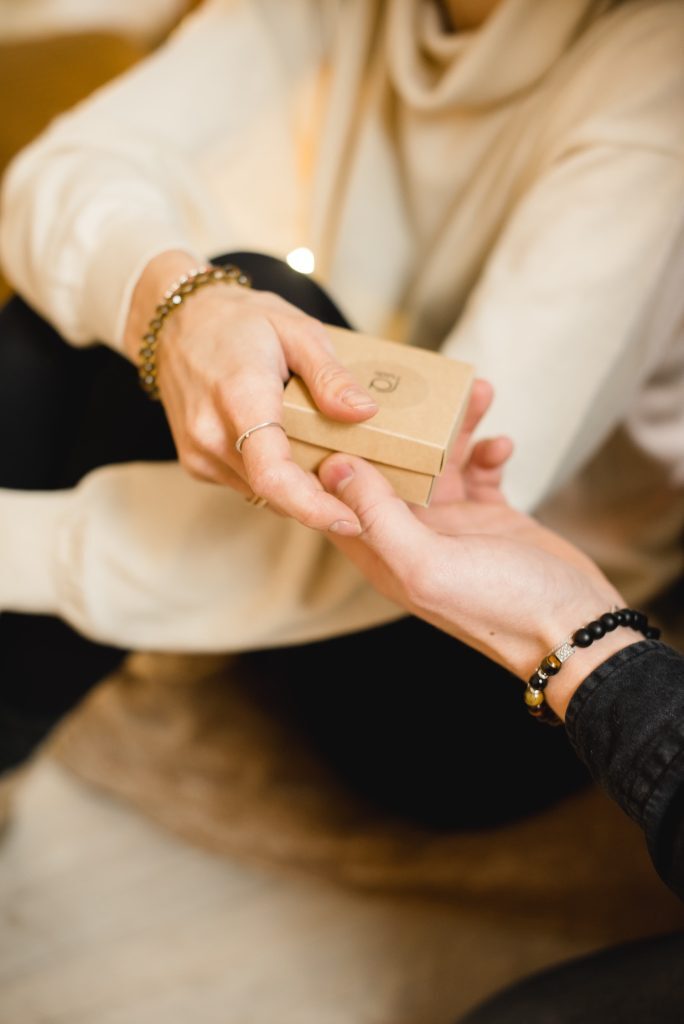Everything You Need to Know About the Five Love Languages
Everyone experiences, expresses, and receives love differently, which is why it’s helpful to understand the five different ‘love languages’. Learning about them and recognizing which one resonates with both you and your partner can help strengthen your bond and improve your relationship. In this blog, we examine the Five Love Languages and how to use them to ensure that both of you feel appreciated.

Everyone experiences, expresses, and receives love differently, which is why it’s helpful to understand the five different ‘love languages’. Learning about them and recognizing which one resonates with both you and your partner can help strengthen your bond and improve your relationship. In this blog, we examine the Five Love Languages and how to use them to ensure that both of you feel appreciated.
The Five Love Languages are Physical Touch, Quality Time, Receiving Gifts, Acts of Service, and Words of Affirmation. We explore their individual meanings and how they can all be applied in romantic partnerships. Knowing the love languages can allow us to better understand ourselves as well as our partners. It enables us to cultivate healthier, more meaningful connections.
What are the Five Love Languages?
The Five Love Languages is a concept developed by author Gary Chapman to describe the five distinct ways we express and experience love. These five languages are:
- Quality Time
- Words of Affirmation
- Receiving Gifts
- Physical Touch
- Acts of Service
Each of us has a primary love language that resonates with us the most and shapes how we receive love. Some of us also have a secondary love language, which isn’t quite as prominent, but it still matters. Your love language describes what makes you feel the most loved, appreciated, and cherished. The Love Language dreamwork is like a unique code that helps your partner understand how to express their love and affection in a way that is meaningful to you.
There is often confusion around whether your love language is how you show love, how you receive love, or both. To be clear, your love language is how you like to receive love. However, confusion arises because people typically give love in the same way they like to receive it. However, this isn’t always the case. And in these scenarios, it can be confusing as someone might think their partner wants something that they don’t actually need.

It’s essential to learn about our own love language, as well as that of our partner. By understanding the Five Love Languages, we can learn to communicate our needs in relationships more effectively and develop deeper connections with our loved ones.
Below, we explore each love language in detail and provide tips on how to show someone love in that language.
Quality Time: Spending time together in thoughtful and meaningful ways
Quality Time is the love language that emphasizes spending quality time with your partner in a thoughtful and engaging way. This can include things like going on dates, taking a walk together, having meaningful conversations, or simply cuddling up together to watch a movie. Quality Time can also be used to show love by taking an interest in the activities that your partner loves. Showing support for their hobbies and passions can make them feel valued and appreciated.
With Quality Time, it’s important to remember that quantity doesn’t matter as much as quality. Spending two hours talking about nothing, in particular, isn’t nearly as meaningful as talking for half an hour about something important both of you care about.

With this love language, it’s essential to give your partner undivided attention and show them that they are your priority. This means putting your phone away and listening intently to what they are saying.
Quality Time is all about connecting with each other in a meaningful way and giving each other the attention we crave from our relationships. When you practice this love language, it helps strengthen the bond between you and adds more depth to your relationship. By prioritizing quality time together and being intentional in how you spend it, you will help ensure that your relationship remains strong and supportive over time.
Words of Affirmation: Receiving love through words and verbal expressions
Words of Affirmation is the love language that emphasizes using words to express affection, appreciation, and respect for a partner. This type of love language involves positive and encouraging words and expressions of gratitude. It’s also about complimenting them on things they do well or have achieved. If this is your partner’s love language, you have to learn to be mindful of the words you use when communicating with them. Really consider what you are saying and make sure it’s genuine.
Words of Affirmation can be used in many different ways, like giving compliments or expressing love through words of encouragement. It can also take form in writing, such as notes or texts which include meaningful messages. You can also use this type of love language in moments of conflict by expressing empathy and understanding rather than being overly critical or dismissive.
Words of Affirmation is a powerful way to communicate love as it helps create an atmosphere of acceptance and appreciation in relationships. Using affirming words that come from genuine admiration can make both partners feel valued and heard, strengthening the bond between them over time.

Receiving Gifts: Receiving love through tangible objects
Receiving Gifts is the love language that focuses on receiving tangible presents from a partner. This type of love language can be expressed through buying thoughtful presents for someone or simply just picking something up that you know they like when you see it. It’s important that the gifts are meaningful and not just token items.
If this is your partner’s love language, receiving a thoughtful gift can give them an emotional boost and make them feel appreciated. Whether it’s buying them their favorite chocolate bar or picking up some flowers, it’s the thought that counts. Receiving Gifts doesn’t have to involve expensive items. It’s simply finding something that reminds you of your partner or getting something they need but wouldn’t buy themselves. This will show how much you care.

Additionally, taking the time to wrap a present nicely or write a heartfelt card can add sentimental value and make it more special. Receiving Gifts not only shows appreciation and thoughtfulness but it can also serve as reminders throughout a relationship that your partner loves and cares for you deeply.
Giving someone a token of appreciation allows you to show gratitude without having to say anything at all. Essentially, Receiving Gifts is an excellent way to maintain closeness in relationships over time by expressing your feelings without words and reminding your partner you are thinking of them.
Physical Touch: Receiving love physically, such as through hugs or hand-holding
Physical Touch is the love language that focuses on receiving affection through physical interaction. This type of love language can include small gestures such as holding hands, hugging, and cuddling, or larger displays of affection such as kissing, caressing, and sex.
Though many view Physical Touch as a more physical form of expressing love, it’s also incredibly emotional in nature; touching someone in an intimate way can convey more than words ever could for some people. It can be used to show support during difficult times, celebrate successes, and let your partner know you are thinking of them in social situations.
The act of physical touch releases oxytocin—the hormone associated with trust and comfort—which means both partners can connect on a deeper level. This language is all about making your partner feel safe, loved, and secure through physical contact. The smallest touch can make a big impact on someone who speaks this love language. Furthermore, incorporating physical touch into relationships can help build stronger bonds over time by creating deeper feelings of intimacy within a partnership.

Act of Service: Feeling loved when helped with daily tasks
Acts of Service is the love language that focuses on receiving love through acts of kindness and helpfulness. This kind of love language isn’t about grand gestures but rather small everyday acts of service that show your partner you care. These activities can include doing chores around the house, running errands, or helping with a task a partner doesn’t have time to do.
The beauty behind Acts of Service is that little acts can make a big difference; it’s often said that actions speak louder than words, which is the perfect phrase to describe this love language. Doing something helpful for your partner such as taking out the trash or cooking dinner for them shows that you are thinking about them even when they might not be expecting it.

Additionally, taking on duties and tasks can help reduce stress in relationships caused by everyday responsibilities and give couples more quality time together, allowing both partners to appreciate one another more deeply.
Performing Acts of Service reinforces trust and commitment in relationships as well; when someone steps up to help without being asked it sends a message that they are willing to go above and beyond for their partner. Essentially, Acts of Service demonstrate selflessness in a relationship, which is a positive attitude for any couple that wants a happy, fulfilling partnership that will last over time.
How to identify your love language
Identifying your love language can help you build healthier, more fulfilling relationships with those around you. There are a few simple ways to ascertain what your primary love language is.
Pay attention to how people around you express their feelings toward you. Think about which actions or words make you feel most valued. The gestures that give you the most positive reactions can provide clues about your individual love languages. Additionally, reflecting on the moments that bring you joy and make you feel appreciated by your partner provides insight into what makes you feel loved.
Once you identify your own primary love language, it’s important to communicate this to your partner in order to ensure they understand how best to show their affection towards you. It’s also helpful to learn their love language too. Ask yourself and your partner the following questions to find out what each of your love languages is:
1. What makes me feel most loved and appreciated?
2. How do I express love to others?
3. What actions or words make me feel hurt or unloved?
4. How does my partner show their love for me?
5. What makes me feel most connected to my partner?
Answering these questions can provide a better understanding of what works best for you both and can help to strengthen your bond.
You can also take the Five Love Languages quiz to determine your love language.
Why is it helpful to know your partner’s love language?
Knowing and understanding your partner’s love language is a valuable tool for any relationship. Being aware of what your partner needs to feel loved and appreciated can help you express your feelings in more effective ways. It can also enable both partners to have their love needs met, which is essential for a healthy, lasting relationship.
When you don’t know your partner’s love language it can cause communication issues, confusion, and frustration. You may think you are showering your partner with love and appreciation but if you don’t understand their love language, your expression may not be as meaningful to them.

In a relationship, knowing the five languages of love—Physical Touch, Quality Time, Receiving Gifts, Acts of Service, and Words of Affirmation—means couples can tailor their expressions of affection to suit their partner’s preferences. This helps you to avoid miscommunication or misunderstandings which can lead to hurt feelings or unmet expectations.
Additionally, it can be helpful to know each other’s love language if one partner expresses love differently than the other; having an awareness of how each person gives and receives affection makes it easier for both people to feel valued and appreciated by each other. Ultimately, knowing your own and your partner’s love language is an invaluable skill that can strengthen any relationship.
Tips for dating people with each love language
Words of Affirmation
1. Make sure to give your compliments often and be generous with your words of praise. Be genuine and sincere in your expressions of admiration and don’t expect anything in return. These compliments can be about physical appearance but also about internal qualities like intelligence or a sense of humor.
2. Use positive words to encourage your partner when they need it. Show that you believe in them and their goals, this will help build trust and show support.
3. Reassure your partner that you are there for them and that you love them unconditionally, even when things are difficult.
4. Remind your partner that you appreciate them by sending sweet notes or cards. Leave post-it notes around the house or write a heartfelt letter expressing your gratitude for them.
5. Don’t underestimate the value of a simple “I love you”. It can mean the world to someone whose love language is Words of Affirmation.
Physical Touch
1. Show your affection through light kisses, hugs, and caresses when appropriate. You could hold your partner’s hand or cuddle up together on the couch.
2. Don’t be afraid to get creative! Surprise them with massage sessions or show intimacy with actions like surprise touches and gentle kisses.
3. Even something as simple as a hug can mean a lot to someone whose love language is Physical Touch. Don’t underestimate the power of these small gestures to make them feel loved.
4. Show them appreciation through small touches throughout the day like brushing their hair out of their face or rubbing their back when they’re feeling stressed.
5. Don’t forget that sex is a part of Physical Touch, too. It isn’t the only thing, but it is important. Make sure you are both on the same page and show that you’re present during intimacy.

Receiving Gifts
1. Choose meaningful and thoughtful gifts that show your partner you care. Have there been jokes shared that only you understand? Take the time to find something special that reminds them of those moments.
2. Don’t be discouraged if you buy something that isn’t an expensive gift—small tokens of appreciation can go a long way. Receiving Gifts isn’t about the monetary value of the present. It really is the thought that counts.
3. Pick up a bunch of flowers or their favorite snack on your way home from work. They will love to know you were thinking of them at that time.
4. Celebrate relationship milestones by finding the perfect gift for them to let them know how much you value your relationship.
5. Get to know what your partner wants, their favorite books, CDs, or takeaway. Giving them something that is personal shows you understand them and their interests.
Quality Time
1. Make time for your partner, even on days when you’re busy or tired. It shows that you prioritize their needs.
2. Put your phone on airplane mode and be present. Quality time doesn’t have to mean expensive dinner dates or extravagant trips; simple activities like going for a walk together, playing board games, and watching a movie can help your partner feel special.
3. Showing interest in their hobbies and passions is also important. It shows that you care about what matters to them. Listen to them actively and engage in meaningful conversations as this will show that you value their opinion.

4. Do fun activities together such as exploring new places or having relaxing nights in. This helps build and strengthen your connection while having a good time.
5. Create meaningful rituals between the two of you like cooking dinner together once a week or watching movies on a Sunday night. This helps to keep the relationship strong while making pleasant memories as a couple.
Acts of Service
1. Show that you care by doing things for your partner without being asked such as running errands or cleaning around the house.
2. Ask your partner if there’s anything they need help with or any tasks that you can do for them. This will make daily life a bit easier and show that you are considerate of their needs.
3. If they have had a stressful or long day at work, have dinner ready for them when they get home. This gives them a chance to relax and they will greatly appreciate it.
4. Help them with a tedious task they have been putting off. This will show that you are there for them and care about their well-being.
5. Don’t forget that little acts make a big difference too. Things like folding laundry or doing grocery shopping can go a long way.
Do people show and receive love in the same language?
The short answer is: no, not necessarily. People often express and receive love in the same way. However, it’s important to remember that this isn’t always the case.
Someone might show love through giving gifts but they feel most loved when they are hearing words of affirmation. Their partner might read this as Receiving Gifts is their love language, when in fact it’s Words of Affirmation.
This is why communication in relationships is so valuable. It’s important to talk to your partner about what makes you feel loved, respected, and appreciated. Communicate your needs and listen so that you can understand each other’s love language and meet each other’s needs in the best way possible.
Final thoughts about the Five Love Languages
To summarize, there are Five Love Languages; Physical Touch, Words of Affirmation, Acts of Service, Receiving Gifts, and Quality Time. We each have a primary love language which is the language that makes us feel most loved.
Understanding the Five Love Languages can be a powerful tool to help you better connect with your partner. It allows people to build healthier, more meaningful relationships. When you learn to recognize and appreciate your partner’s love language, it gives you insight into how they feel most loved. With patience, understanding, and practice, the Five Love Languages can open the door to deeper connections and lasting relationships.
However, love isn’t one-size-fits-all. Each relationship is unique and it’s important to remember that what works for one couple might not work for another. Every person is different, so it’s important to be flexible and keep an open mind when exploring the Five Love Languages in your relationship. At the end of the day, all relationships require communication, patience, and understanding.
To understand more, you can check out the love language of each personality type. If you don’t know your personality type, you can take our free 5-minute personality test.





